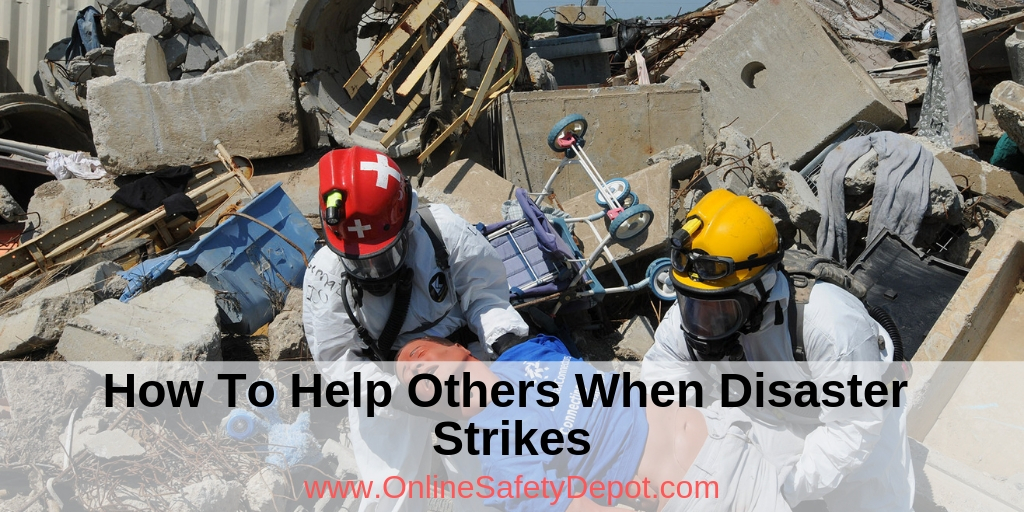How To Help Others When Disaster Strikes
Some years ago, when I was living in California, I experienced my first earthquake. Being from Idaho, I had never experienced an earthquake before. It was 7 am, and I had just sat at my desk to start work for the day. Suddenly, the walls started shaking, and a few pictures fell off the wall.
Because it was a smaller (4.0) earthquake, there was minimal damage to the homes in the area. For me, it was an incredible experience. However, for many of my neighbors, it was a terrifying moment as they have experienced much worse in the past that destroyed their homes, cars and even claimed the lives of their friends and family.
Had the earthquake been much more destructive and destroyed the homes, roads and claimed lives, I would have had no clue how to help my neighbors.
FEMA has a great Program (CERT) that focuses on training community members on how to respond to natural and human-made disasters. After studying the training manual, this is what I learned.
1- Individuals who are untrained may get hurt themselves
2- Search Operation Procedures
3- Rescue Operation Procedures
NOTE: Search and Rescue operations should only be conducted by trained personnel. You can become certified by taking the CERT Program or other certifiable training courses. To learn more about the CERT program, read our other article “Overview of the Community Emergency Response Team Program- CERT” or “The Community Emergency Response Teams (CERT).”
Risks of Helping Others if you are Untrained
Before you ever attempt to rescue trapped individuals, you need to learn how to size up the situation to determine the risks involved and to responsibly prioritize your safety first.
Size Up the Situation
As part of the CERT Program, individuals are taught to follow the “9 steps to sizing up the situation”.
Step 1: Gather facts
Step 2: Assess and communicate damage
Step 3: Consider probabilities
Step 4: Assess your situation
Step 5: Establish priorities
Step 6: Make decisions
Step 7: Develop action plans
Step 8: Take action
Step 9: Evaluate progress
It is essential to follow these steps to ensure your safety as well as the safety of those around you. If you are untrained at search and rescue and you rush into a half fallen building after disaster strikes without sizing up the whole situation, the structure may collapse on top of you. If you rush in to help someone else and end up getting hurt yourself, first responders now need to focus on rescuing two injured individuals rather than one.
Search Operation Procedures
Personal Protection Equipment
Ensure you have the proper safety equipment such as gloves, helmet, protective eyewear, boots, mask, and any other Personal Protective Equipment needed before you begin the search operations.
Buddy System
Search and Rescue operations are always done in pairs-often referred to as the “Buddy System”. Never begin search operations alone. If you get hurt, your buddy can inform others who can come to your aid.
The buddy system is made up of at least three individuals. The first two are designated to searching the area while the third individual acts as a runner. The buddy system is designed to protect yourself and others who are searching through the rubble.
NOTE: Throughout the search operation, rescuers should be continuously sizing up the situation. Each new room, building, and area poses new threats that were previously unseen or undetected. Look for any overhead objects that could fall on top of you, live powerlines, sharp objects, smoke, gas leaks or any other potential hazards.
You may begin the rescue operation after you have carefully sized up the situation, gathered necessary Personal Protection Equipment and formed buddy systems for each rescue party.
Rescue Operation Procedures
There are many reasons why someone may need to be rescued. For example, individuals may be: trapped in a confined space, lost in the dark, pinned under a heavy object, unable to move due to injury or may be unconscious.
Knowing what to do in each of these situations will enable you to rescue an individual who needs help more effectively. Some techniques to rescuing others are:
Leveraging and Cribbing: This technique is used to lift/leverage a large board, beam, or section of the building that has fallen on top of an individual and placing some other object under the object for support which allows you to remove the individual from underneath.
Debris Removal: Often you may need to remove the fallen down debris such as wood, bricks, rocks, or any other debris that has fallen and trapped individuals.
Removing the Individual: Once you have located and freed the trapped individual, you will need to get them to safety where they can receive the required medical care. Depending on the injury or mobility level, the number of rescuers with you and the environment in which you need to remove an individual from, you’ll need to remove them using one of the methods mentioned below:
– Self-removal or assist
– One-person carries
– Two-person carries
– Group carries
– Dragging
Conclusion
Search and rescue in extremely dangerous and should only be done by someone who knows what they are doing, has the appropriate safety gear and is with a team of others, known as a “Buddy System.” If you would like to be trained in how to conduct search and rescue operations properly, consider taking the CERT training program or some other certifiable training course that can educate you on the proper guidelines for search and rescue.

